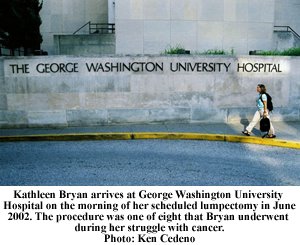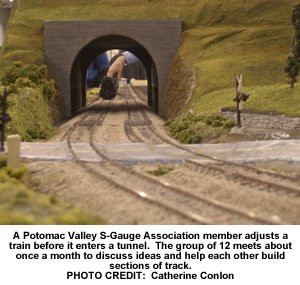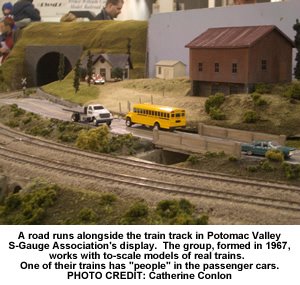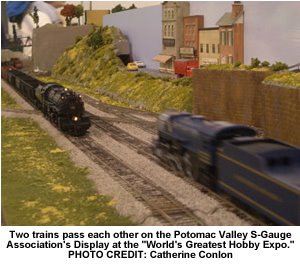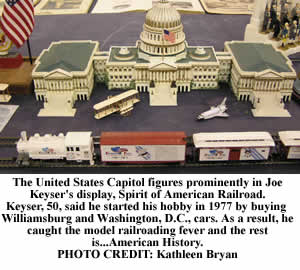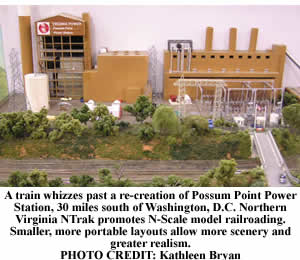blog
Saturday, February 25, 2006
Reporter's Dispatch
Many of us believe that things happen to us. Well, cancer happened for me. Insidious and stealth, it came along without warning, stealing the wind from my sails and leaving me feeling powerless.
The healing process has been slow, especially internally. Sharing my story soothes my soul and helps me come to terms with my doubts and fears. A friend of mine once said, “The universe rewards forward momentum.” Small steps I take to reclaim my life.
It was a joy to report the stories in this series. Dr. Bernard Chang is one of the kindest physicians that I have ever met. Chang is in such high demand that his surgical consultant, Sonya, often has to schedule his surgical procedures months in advance.
Photographer Ken Cedeno e-mailed me his award-winning picture story. Robert Visser, a mutual friend and photographer, helped me build the slide show, and I wrote captions. Thanks to Visser’s technical expertise the slide show looks great. I interviewed Cedeno, and then we uploaded the audio clip to my blog.
The Women’s Boutique, a specialty store in Baltimore, Md., offers health related products and services to women. I first met Elisa Lawson and her daughter Jennifer Knott last April due to my preoperative fitting for surgical garments. My interview with Lawson was a breeze; she loves what she’s doing and was more than willing to share her story.
All in all, it was an excellent opportunity to report meaningful stories.
Master Surgeon
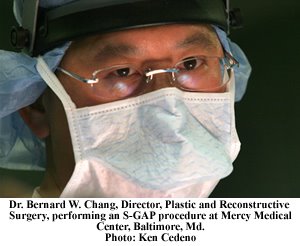 A breast cancer diagnosis can elicit a near heart-stopping response for many women.
A breast cancer diagnosis can elicit a near heart-stopping response for many women.Those who undergo a mastectomy can opt for reconstructive surgery, including skin expansion and an implant or flap reconstruction. Surgeons performing flap reconstruction harvest tissue from another area of the body and use it to recreate a new breast.
But it’s just in the past 10 years that women with little or no tissue in their back or abdomen can look to their derriè
“S-GAP flap has been a viable procedure for about 10 years; consistently, there are only about five to six surgeons [in America],” said Dr. Bernard W. Chang, Director, Plastic & Reconstructive Surgery, Mercy Medical Center in Baltimore, Md. “It is such a small group because it is a difficult operation,” added Chang.
Superior gluteal artery perforator (S-GAP) flaps “provide a reliable flap and an excellent aesthetic reconstruction,” according to an article published in Annals of Plastic Surgery, February 2004. The makeup of the gluteal region’s fatty tissue enables surgeons to design and create breasts with “good projection” and mass, resulting in a breast that looks and feels natural.
“I suppose it does take some artistic sense to do an S-Gap flap,” admitted Chang with a twinge of humility. “It is a combination of technical skill and aesthetics.”
Chang, a soft-spoken and gentle practitioner, was operating on the cutting edge when he started doing S-GAP flaps in 1997. “I have been focused on breast reconstruction since starting in plastic surgery at [Johns] Hopkins [University School of Medicine] in 1992.”
Chang said that over the years he has worked with many women dealing with cancer and surgical problems. He has witnessed many “with much strength in the face of adversity.”
“I feel a great sense of joy in knowing that so many women were able to regain their sense of wholeness and self-esteem," said Chang. “I wish more women could benefit from what we do, and hopefully in the future more plastic surgeons will be able to offer these procedures to patients.”
Friday, February 24, 2006
The Women's Health Boutique: A Safe Haven
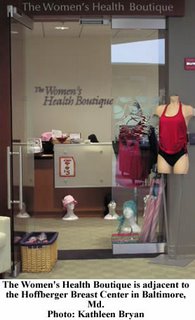 Early in her career, Elisa Lawson packed $8,000 worth of prostheses in her car trunk and drove from Kent Island, Md., to the Pennsylvania line plying her goods to post-mastectomy women.
Early in her career, Elisa Lawson packed $8,000 worth of prostheses in her car trunk and drove from Kent Island, Md., to the Pennsylvania line plying her goods to post-mastectomy women.“I honestly started up with my breast forms literally in my trunk,” said Lawson. A Certified Prosthesis Specialist, Lawson learned her craft while working in the lingerie department at Nordstrom’s in the late 1990s. Clients with breast cancer were rare, she said; however, Lawson remembers the day she fitted a cancer survivor who made a sizable purchase.
 “She felt like a million bucks when she left,” Lawson said. But the woman ended up returning everything because her insurance company wouldn’t recognize Nordstrom’s as a legitimate supplier of post-mastectomy products. “I felt so sad when the woman came back,” added Lawson. “It was so unfair that she couldn’t have these products.”
“She felt like a million bucks when she left,” Lawson said. But the woman ended up returning everything because her insurance company wouldn’t recognize Nordstrom’s as a legitimate supplier of post-mastectomy products. “I felt so sad when the woman came back,” added Lawson. “It was so unfair that she couldn’t have these products.”Inequitable practices by the insurance companies sparked Lawson’s interest in helping breast cancer survivors. She left Nordstrom’s determined to make a difference. “I felt like the business needed to move to a more personal setting and take care of the needs of every single woman,” Lawson said.
Her traveling sales business segued into a modest retail space at Mercy Medical Center, due in part to the doctors on staff. In 2003, Lawson opened The Women’s Health Boutique, a stylish and intimate shop where women can have privacy and explore their options.
“We work really closely with the surgeons here,” remarked Lawson. “We develop relationships with the patients before surgery; they learn to feel more comfortable with us and with their scars.”
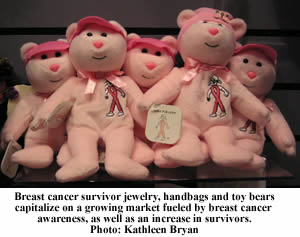 In addition to custom silicone foam prostheses and silicone gel breast forms, The Women’s Health Boutique offers pre-surgical garments, post-mastectomy bras and camisoles, mastectomy swimwear and breast cancer survivor jewelry, scarves and handbags.
In addition to custom silicone foam prostheses and silicone gel breast forms, The Women’s Health Boutique offers pre-surgical garments, post-mastectomy bras and camisoles, mastectomy swimwear and breast cancer survivor jewelry, scarves and handbags.Lawson said that she’s not aware of any other hospital with a similar boutique. “What’s unique about Mercy is right here, next to the Breast Center.”
It's About Courage
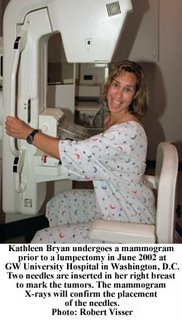 On a warm day in June 2002, I stood on a D.C. subway platform and asked, “How could this be happening to me? I don’t understand this." My ex-husband, Karsten, stood some distance away as I pondered such a frightening thought.
On a warm day in June 2002, I stood on a D.C. subway platform and asked, “How could this be happening to me? I don’t understand this." My ex-husband, Karsten, stood some distance away as I pondered such a frightening thought.I felt lost. No one on the platform had an answer for me. Earlier in the day, after our consultation with the surgeon, Karsten’s eyes welled up with tears as he said, “I can’t make up for you not being here. Lukas will miss you.” I swallowed hard as reality gave me a one-two punch.
There’s nothing like cancer staring you in the face. Thank goodness for the wisdom of a little boy. “Mommy, at least you’re not losing something more precious,” said Lukas during dinner on a sultry July evening. “I’d rather lose a breast than my life.”
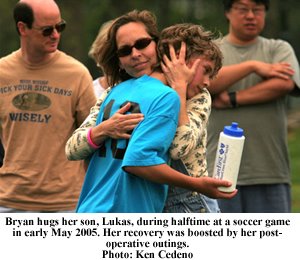 The insight, the perspective: it was sweet yet also sobering. The mastectomy was necessary; it provided me with the greatest odds for survival and has given me precious time with my son. Cancer was tough, but I was tougher. It tried to wear me down; instead, it infused me with courage, strength and good humor.
The insight, the perspective: it was sweet yet also sobering. The mastectomy was necessary; it provided me with the greatest odds for survival and has given me precious time with my son. Cancer was tough, but I was tougher. It tried to wear me down; instead, it infused me with courage, strength and good humor.The diagnosis, and subsequent issues with my saline implant, also spurred me to reflect and to think of the possibilities in my life. It was clear that my journey was a defining chapter, and that it was important for me - as a woman and as a journalist – to document the moments of both joy and despair.
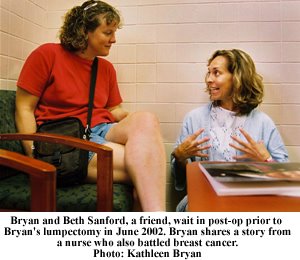 My friends Robert Visser and Ken Cedeno, both photojournalists, began a collaboration of spirit and storytelling. Cedeno and Visser spent countless hours with me, watching and waiting for just the right moment to click the shutter.
My friends Robert Visser and Ken Cedeno, both photojournalists, began a collaboration of spirit and storytelling. Cedeno and Visser spent countless hours with me, watching and waiting for just the right moment to click the shutter.Both men have thanked me for inviting them on my journey. It’s really I who should be thanking them. Their support and love steadied me every step of the way. I would have faltered if it were not for their presence and strength.
With the exception of Dr. Bernard Chang at Mercy Medical Center in Baltimore, my medical team was made up of incredible women, including Dr. Shawna Willey, now at Georgetown University Hospital, and Dr. Joanne Lenert, a plastic surgeon at George Washington University Hospital. Both women were patient and kind, and were always willing to answer my questions with honesty and wisdom.
I feel very blessed. Cedeno, Visser and I might have to write a book about our adventures.
A Labor of Love
Photojournalist Ken Cedeno’s sensitive story about a local cancer survivor was recently honored by the White House News Photographers Association for 2006 in the “Eyes of History” still photography contest. Cedeno won an “Award of Excellence” for his picture story (feature) entitled, “Cancer.”
“I feel wonderful! It’s really nice to know that I was able to get a good story because I was given great access,” said Cedeno. “I feel very pleased about the award.”
Cedeno’s subject and friend, Kathleen Bryan, was diagnosed with breast cancer in May 2002, which led to a mastectomy with breast reconstruction. In 2005, she underwent a second reconstruction due to problems with her saline implant.
With about 20 years in the business, Cedeno said that “photography has always tugged at me...I want to be a part of showing and sharing the news. I’m doing what I feel strongly about.”














Click on the play button to listen to photographer Ken Cedeno speaking about reporting on Kathleen Bryan's cancer journey.
AUDIO: Kathleen Bryan
What's a Blinq?
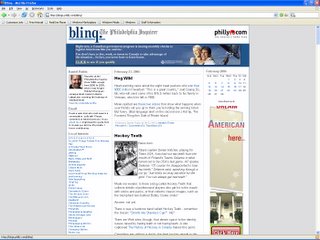 Okay, so you’re boning up on all this new Web terminology. You get what a blog is, and you have the feeling that a weblog might be similar, but what is a blinq? Well, I learned something new thanks to reporter Daniel Rubin of The Philadelphia Inquirer. It turns out that a blinq – an abbreviated combination of blog and Inquirer – is in fact a blog.
Okay, so you’re boning up on all this new Web terminology. You get what a blog is, and you have the feeling that a weblog might be similar, but what is a blinq? Well, I learned something new thanks to reporter Daniel Rubin of The Philadelphia Inquirer. It turns out that a blinq – an abbreviated combination of blog and Inquirer – is in fact a blog.Rubin, a prolific blogger, devotes his blog to the business of entertainment. You name it, he blogs about it - everything from breaking news to poetry. Actually, Rubin’s news dispatches are quite good, and at times provides unconventional and much needed perspective on a subject. His posts about the business of entertainment are – for lack of a better word – entertaining. Rubin’s offbeat sense of humor results in some pretty comedic slices of life, including a post about professional hockey players who lose their teeth. He relies heavily on text and sometimes includes a photo or illustration in his posts.
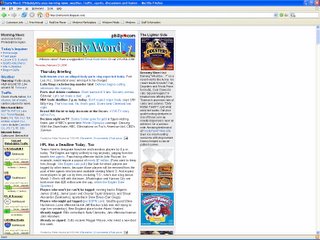 Reporter Peter Mucha writes a blog titled “Early Word” that provides breaking news on weekday mornings, as well as views on a variety of subjects. His posts on sports and the business of sports reveal an astute knowledge and passion. Mucha uses very little graphic eye candy and depends on links to round out his stories.
Reporter Peter Mucha writes a blog titled “Early Word” that provides breaking news on weekday mornings, as well as views on a variety of subjects. His posts on sports and the business of sports reveal an astute knowledge and passion. Mucha uses very little graphic eye candy and depends on links to round out his stories.
It’s difficult to get an accurate read on the blogging efforts by The Philadelphia Inquirer. Mucha and Rubin seem to be the primary bloggers, posting a wide range of stories, views and opinions. Philly.com, linked to both The Philadelphia Inquirer and The Philadelphia Daily News, currently has an interactive blog about a 41-year-old mother who is battling cancer. It’s a beautifully done story with photographs and an audio link.
The Post-Standard Strikes Out
 Syracuse, N.Y., a working class town that thrives on sports and local politics, lacks the sophistication often associated with large cities. This is also clearly evident in the The Post-Standard, the print and online versions of the local paper. Users access the site’s blogs or weblogs via “Living” on the navigation bar and then click on “Weblogs,” which links to a page that lists News & Biz Blogs, Sports Blogs and Entertainment Blogs.
Syracuse, N.Y., a working class town that thrives on sports and local politics, lacks the sophistication often associated with large cities. This is also clearly evident in the The Post-Standard, the print and online versions of the local paper. Users access the site’s blogs or weblogs via “Living” on the navigation bar and then click on “Weblogs,” which links to a page that lists News & Biz Blogs, Sports Blogs and Entertainment Blogs. Approximately 15 blogs cover high school, college and professional events at the local and state level. The news blogs spotlight local happenings, including endorsements of Eliot Spitzer for governor and Andrew Cuomo for attorney general, as well as short stories with curious headlines such as, “Truck ends up in Butternut Creek.” The entertainment blogs utilize a more informal writing style and incorporate more photos. From a visual standpoint, these postings are far more interesting than the news and sports blogs.
Approximately 15 blogs cover high school, college and professional events at the local and state level. The news blogs spotlight local happenings, including endorsements of Eliot Spitzer for governor and Andrew Cuomo for attorney general, as well as short stories with curious headlines such as, “Truck ends up in Butternut Creek.” The entertainment blogs utilize a more informal writing style and incorporate more photos. From a visual standpoint, these postings are far more interesting than the news and sports blogs.A blog titled “The Daily Dose” seems to provide a daily dose of truly weird stuff, such as the impact on a cell phone when dropped into a toilet. The writing is far more informal than used in the entertainment blogs, and from my perspective not entirely appropriate for a news site.
The blogging efforts of The Post-Standard site reveal a blatant lack of consistent news value, and in specific postings, a mature and seasoned approach to the dissemination of news. Syracuse is home to Syracuse University and the S.I. Newhouse School of Public Communications; one would think that a school of this stature could inspire quality journalism in its hometown newspaper, not to mention the pool of available talent that could lead the charge.
Thursday, February 23, 2006
A Touch of Elegance
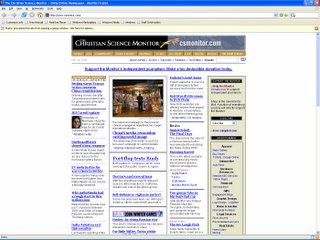 The Christian Science Monitor’s site is an excellent example of the successful marriage of color, simple lines and thoughtful reporting. It’s a pleasure to access a site that’s intelligent and thought-provoking. A quick scroll reveals the links to the Web columns and blogs, which vary in length and subject matter.
The Christian Science Monitor’s site is an excellent example of the successful marriage of color, simple lines and thoughtful reporting. It’s a pleasure to access a site that’s intelligent and thought-provoking. A quick scroll reveals the links to the Web columns and blogs, which vary in length and subject matter.The site’s navigation is well-organized and fairly consistent throughout, giving the user a sense of streamlined order. Although the use of photography is minimal in some of the posts; the color palette and design elements make up for the lack of visual story anchors. When photography is incorporated into stories, the images are rich and graphically size appropriate. Although the print edition of The Christian Science Monitor is smaller than most newspapers, the paper has a brilliant sense of how to use photography. The online version could certainly benefit from this approach.
Posts or stories are well written; however, some of the stories are quite long and require the user to do quite a bit of scrolling. But the subject matter and quality of writing – in some cases - make up for a reporter’s lengthy story. A variety of links provide supplemental information, yet video and audio links could enhance the stories and the site in invaluable ways.
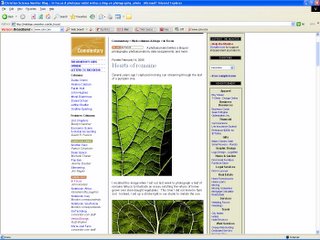 Of particular note is a beautifully executed collection of images taken by a photo-
Of particular note is a beautifully executed collection of images taken by a photo-journalist of the most ordinary things, including romaine lettuce. Beauty and exquisite moments are certainly in the eye of the beholder.
Diner's Delight
Nearly two years ago a former war correspondent and Pulitzer finalist took an unexpected turn - a gastronomic leap. Frank Bruni, a man who fellow reporters describe as having a “true and longstanding passion” for food, succeeded Bill Grimes as the The New York Times restaurant critic. A self-avowed foodie, Bruni reports on the sacrosanct and fabulous world of chefs and their cuisine.
 Bruni’s weekly column, “Diner’s Journal,” synthesizes his reviews and musings on the New York restaurant scene. In mid-February, Bruni launched a Web version based on his popular Friday column. From the paper’s homepage users click on “Dining & Wine” to access Bruni’s blog. It’s not hard to miss as the headline, in red, is accompanied by an illustration of a diner with fork and pencil in hand, as well as a small notebook on a plate. Users might expect to see foie gras or a steaming plate of sumptuous mussels, yet Bruni’s graphic provides a hint of what’s to come.
Bruni’s weekly column, “Diner’s Journal,” synthesizes his reviews and musings on the New York restaurant scene. In mid-February, Bruni launched a Web version based on his popular Friday column. From the paper’s homepage users click on “Dining & Wine” to access Bruni’s blog. It’s not hard to miss as the headline, in red, is accompanied by an illustration of a diner with fork and pencil in hand, as well as a small notebook on a plate. Users might expect to see foie gras or a steaming plate of sumptuous mussels, yet Bruni’s graphic provides a hint of what’s to come.In his introductory blog post, Bruni writes that the Web version of “Diner’s Journal” is an "attempt to capture and share more of my notes from the field.” Colleagues Barbara Graustark and Sam Sifton, in a press release announcing Bruni’s ascension, wrote, "Frank's writing about restaurants displays not only real and considered knowledge about the food on the plate, but also true empathy for the diner."
 Bruni’s blog provides users with wonderful reality bites of the New York restaurant scene. He reports on everything from décor to the new chefs on the block. Bruni also - and quite deliciously - ruminates about the issue of automatic gratuity, his weight and the outfits worn by servers at Hooters. Comments made by users are entertaining and on occasion challenge Bruni to scale new heights in his reportage, including a chef’s dare that Bruni be a waiter for a week.
Bruni’s blog provides users with wonderful reality bites of the New York restaurant scene. He reports on everything from décor to the new chefs on the block. Bruni also - and quite deliciously - ruminates about the issue of automatic gratuity, his weight and the outfits worn by servers at Hooters. Comments made by users are entertaining and on occasion challenge Bruni to scale new heights in his reportage, including a chef’s dare that Bruni be a waiter for a week.“Diner’s Journal” is not an especially eye-catching blog; however, photographs do complement the stories and links enable users to access a wide variety of restaurant and related sites. The real joy is in the delectable visualizations that Bruni creates for connoisseurs of New York’s eclectic cuisine offerings. Bon appétit!
Wednesday, February 15, 2006
Hear That Whistle?
The trains have all pulled out of the station, and the World's Greatest Hobby Show is over. Please enjoy our archived posts.
Producer/editor: Linda Sponsler
Writer: Cari DiMargo
Photographers and writers: Catherine Conlon & Kathleen Bryan
It's a Kid's World
 "I like the whistle,” said Sydney Rymes, age 5, at the World's Greatest Hobby Show. “It's like a really loud tooting sound."
"I like the whistle,” said Sydney Rymes, age 5, at the World's Greatest Hobby Show. “It's like a really loud tooting sound."Sydney, from Jefferson, Md., accompanied her family to this unique event that entertains kids of all ages. Babies in strollers watched patiently as their older siblings pretended to be train conductors in the hands-on train playground.
The goal of the World's Greatest Hobby On Tour is to get the younger generation interested in model railroading. Promoter Dave Swanson noted that two-thirds of the show's attendees are under 16. “I love model railroading and I want it to continue to be a popular hobby,” said Swanson. “If you don't get into it as a kid, you won't get involved as an adult.”
 The 100 “Thomas the Tank Engine” trains delighted Jake Koneczny, 4, of Burke, Va. “I haven't been able to get him away from the Thomas trains. He wants to buy everything he sees,” said Chuck Tamasi, Jake's grandfather.
The 100 “Thomas the Tank Engine” trains delighted Jake Koneczny, 4, of Burke, Va. “I haven't been able to get him away from the Thomas trains. He wants to buy everything he sees,” said Chuck Tamasi, Jake's grandfather.Despite today's winter storm warning, the crowds are brisk at this family-friendly hobby show at the Dulles Expo Center. Neither snow, nor sleet, nor dreary rains, deters them from seeing those fabulous trains!
The Disney Express
Michael Broggie rode the Disneyland railroad on its first voyage around the park, and he's got the picture to prove it. The enlarged black and white picture hangs today at the Walt Disney's Railroad Story booth at the World’s Greatest Hobby Show.
Broggie’s father served as Disney's first engineer. "I literally grew up in Walt Disney’s backyard," Broggie said. "The idea of Disneyland came out of the backyard train set."
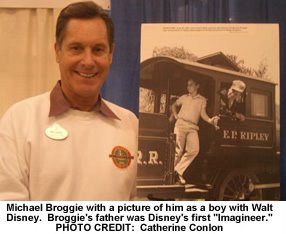
Today, Broggie is the founding chairman of Carolwood Pacific Historical Society, which creates railroad products for the Disney corporation. Expo visitors were snapping up Broggie's $70 hardcover Disney biography and the slim children's version. He signed stacks of books in a practiced imitation of Disney’s scrawl. The Martin family of Warrenton, Va., asked Broggie to sign both books and a CD. Carla Martin, 12, posed for a picture.
"A lot of youngsters today don’t realize that Walt Disney was a real person," said Broggie. He's certainly more eager to talk about Disney than himself -- and he's doing his best to share his memories of the 2,600 feet of train tracks that once covered Walt Disney's backyard.
Virtual Railroad
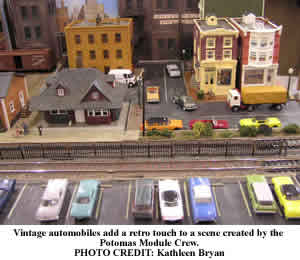 Retro trains whiz past 1940s- and '50s-era cars, all tailfins and turquoise. Urban settings consist of window pane-covered factories; tiny wooden farm houses dominate the rural areas.
Retro trains whiz past 1940s- and '50s-era cars, all tailfins and turquoise. Urban settings consist of window pane-covered factories; tiny wooden farm houses dominate the rural areas.The Potomac Module Crew's train display is old-fashioned, but state-of-the-art technology makes it happen.
Each engine has an encoder, and train owners control them remotely with wireless devices called throttles. "Engineers" can determine direction of engines regardless of the way they're facing. Digital Command Control has been around for about 10 years, and it's still cutting-edge.
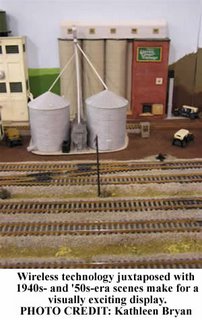
"The technology is so close that anything that happens on the real railroad happens here," said Ralph Douglas, a member of several DC-area train clubs, including the Potomac Module Crew. Douglas should know: He's also a volunteer engineer for the Walkersville Southern Railroad in Frederick, Md.
You Go, We Go, LEGO
 Turns out that "blockhead" isn't always an insult, at least for members of the Washington, DC Metropolitan Area LEGO Train Club. Their display at the World's Greatest Hobby Show had visitors gasping with delight and eagerly pointing out hidden details, some staggeringly minute. A skeleton sits abandoned on a hill; Jar Jar Binks of "Star Wars" notoriety is just another bus passenger. Spider-Man scales the side of a building. A brave soul is perched at the top of a waterfall, poised to go over in a barrel.
Turns out that "blockhead" isn't always an insult, at least for members of the Washington, DC Metropolitan Area LEGO Train Club. Their display at the World's Greatest Hobby Show had visitors gasping with delight and eagerly pointing out hidden details, some staggeringly minute. A skeleton sits abandoned on a hill; Jar Jar Binks of "Star Wars" notoriety is just another bus passenger. Spider-Man scales the side of a building. A brave soul is perched at the top of a waterfall, poised to go over in a barrel.Harry Potter, R2D2 and Dracula hang here, too, tucked away among H2 SUVs, the old woman's shoe house, a Wild West town and a comfy little village with 17 homes.

The human touches mingle with a computer-generated track design. LEGO Train Club member Bob Hayes freely tells admirers the software is free on the Internet. This morning's four-hour set-up, of course, doesn't include the three months of construction on a majestic 1930s-style train station.
LEGOs aren't cheap, but Hayes says they've been building their collection for years. He gave away his childhood LEGOs at age 13, but started collecting them again when he became a dad. This display contains about $10,000 worth of equipment, easily out of the range of the average 13-year-old. "That's kind of why we're an adult club," said Hayes. A kid's hobby on an adult's budget? Priceless.
Turn Up the Trains
A familiar howl cuts over the din at the Dulles Expo Center, where the World's Greatest Hobby Show (yes, model trains) has chugged into town. The thumping beat and muscular yowl of steam and diesel engines provides an appropriate soundtrack on compact disc.
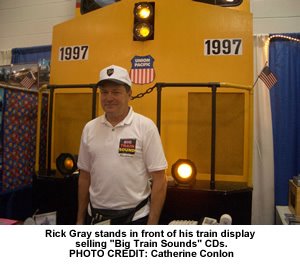
"They sound more like the trains than the train," quips Rick Gray, owner of Big Train Sound. He created his first disc in 1994 as an audio backdrop for his own model trains. “Back then, all you could get was a $300 sound module,” he said.
Gray sells his five discs for $20 a pop: steam, diesel, "Heavy Metal" (steam and diesel mix), early diesel, and one disc of motorcycle sounds: "Big Bikes, Big Thunder." He collects digital samples from railroad yards and crossings, then synthesizes and edits the sound files.
The discs dish up decent white noise as well: Gray said some of his customers purchase the CDs to play while they sleep.
Click on the play button to listen to the "Big Train Sounds"
that Rick Gray played on his display sound system.
AUDIO CREDIT: Catherine Conlon
Wednesday, February 01, 2006
A Mid-Summer's Journey to Denmark
 Last summer I traveled to
Last summer I traveled to
But I would not see

We landed in
The drive across Vejle Fjord was an early morning gift as the sun’s rays danced upon the water. Five kilometers north of Vejle I left the main highway and drove on two-lane roads until I reached

Gyda and Lukas were totally surprised to see me before mid-afternoon. My early arrival was impressive and I felt pretty proud of myself for shattering all previous records held by Karsten. Both Lukas and Gyda glowed. I could see that the summer had treated them well. The following days seemed like a blur – wondrous and magical – as we visited family, hiked to the top of Himmelbjeret, one of
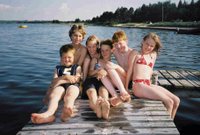
What was particularly special to me was watching Lukas embrace his Danish roots. He has a deep connection to his grandmother, uncles, aunts and cousins as well as to the land and its customs. It was delightful to hear Lukas speaking Danish with his grandmother and note that it was fairly effortless.
A mid-summer’s journey to
Photo 1: Kathleen Bryan
Lukas presents his grandmother with a ceramic vase that he made for her in honor of her 70th birthday.
Photo 2: Kathleen Bryan
Located in central Jutland, Ikast's economic base is sustained by educational and training institutions, agriculture and service industries, including computers, design and marketing.
Photo 3: Kathleen Bryan
The Himmelbjeret Tower, 25 meters high, was erected to commemorate King Frederik VII, who on June 5, 1849 gave the Danish people its free constitution. The tower has a frieze bearing the inscription: In commemoration of the King - Frederik VII - a friend of the Danish people - the giver of the Constitution.
Photo 4: Kathleen Bryan
Lukas with some of his Danish cousins on the dock at Lundø Fjord.
